|
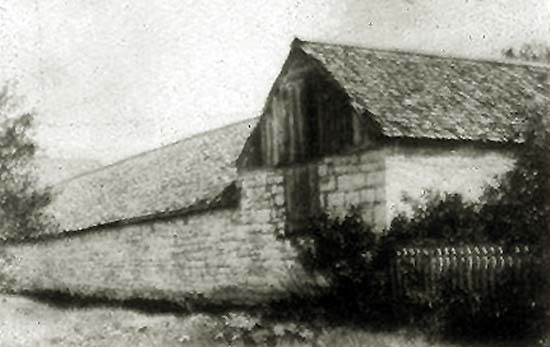
Post Sutler's Stables, Fort Bridger.
The above photo has not been definitively dated, but is believed by the writer to date to about the
turn of the Twentieth Century.
Following the Mormon War, Fort Bridger was mainly associated with the post sutler, William Alexander Carter (1818-1881),
one of the significant characters of Wyoming.
Carter, born in Prince William County, Virginia, came to the Fort with
Albert Sidney Johnston in 1858. His appointment as sutler, however, was as a result of his
friendship with Gen. William S. Harney dating from the Second Seminole War in Florida. Harney, commander of the
Second Dragoons was orginally to lead the expedition against the Mormons, but the Second Dragoons were
left in Kansas to deal with difficulties arising there. Thus, Johnston was assigned. During the
Second Seminole War, Carter was post sutler at a number of forts in East Florida. It was, therefore, only natural that his
old friend, Gen. Harney, would invite Carter to be sutler on the proposed expedition against the Mormons. Correspondence at the Florida
Historical Library also indicates that during the Seminole War Carter became acquainted with a young, newly minted Lt.
William T. Sherman, advancing the lieutenant $14.00. Another young West Point graduate to whom credit was extended was
Edward Otho Cresap Ord, later a Major General. Friendships earned in the Army were lasting. Later at Fort
Bridger, Carter hosted Generals Sherman, Harney, and Ord. Indeed, in addition to appointing Carter as
Sutler for the Morman Campaign, Harney later presented Mrs. Carter, as a gift, his personal private coach which he had imported from
France.
According to a letter dated January 17, 1934, [Florida Historical Library] from the Secretary of the Historical Section, the Army War College, to
Carter's grandson, Edward F. Corson, Carter's involvement with the Second Seminole War began with his enlistment in the Army on July
1, 1836. He originally attempted to enlist underage with the permission of his mother. Young Carter was assigned to Company A, Second U.S. Dragoons for service in Florida.
Among the battles he participated in was one on Feb. 8, 1837, at Lake Monroe, north of present-day Orlando.
Thirteen months after his enlistment, Carter was mustered out on disability on August 12, 1837, at Fort Marion, St. Augustine, Florida, with a rank of sergeant. In St. Augustine,
troops were housed in a former Roman Catholic
monastery. The monastery was converted to military use by the British in 1768. The British had no use for
a Roman Catholic monastery. It has remained in military use ever since under the British, the Spanish, the American Army, and the
Confederacy. It is now the headquarters for the Florida National Guard. But even before his
discharge, Carter had already begun to show business acumen establishing himself as post sutler at
for the Third Artillery. Sutlers were commissioned to serve forts as well as on the regimental level.
They were, just as a present-post exchange, commissioned to sell goods not provided to the
soldiers by the Army. A letter to Carter from W. A. Brown indicated the types of goods required. The list
included brown sugar, tea, butter, tobacco, molasses, mustard, pickels, pepper, thread, pipes, shaving glasses, plates, forks, and lemon syrup.
Correspondence, however, indicates that his business was spread over all of East Florida, with
subposts at Key Biscayne near present-day Miami, New Smyrna, Fort Hanson near present-day Hastings, and Fort Peyton south
of St. Augustine. Correspondence held by the Florida Historical Society as well as an 1840 deed indicates that Carter maintained his
residence in St. Augustine.

Fort Bridger Stables, 1926.
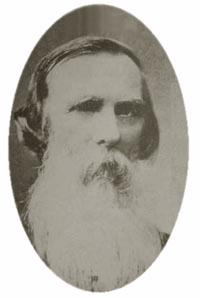 W. A. Carter W. A. Carter
Life in Florida, at the time, was quite hazardous.
The Second Seminole War (1835-1842) started with the savage murder of the Indian agent and the post sutler at Fort King (present-day Ocala) and the
Dade Massacre in which there was but one survivor. Maintenance of the sutler's store at Key Biscayne rather than on the mainland at
Fort Dallas, may have lessened
the danger of Indian attack, but did not guarantee safety. In 1836, as an example, Indians attacked the
a settlement at New River (present-day Ft. Lauderdale) killing the family of a local justice of the peace. At the time, the area encompassed
by modern-day South Florida may have had a total population of about 60. The Indians then turned
their attention to the lighthouse on Key Biscayne. The lighthouse was tended by an assistant light keeper, John Thompson and
an elderly slave, Aaron Carter. The name of the slave leads to speculation that he may have
belonged to William Carter since slaves took as surnames the names of their masters. Thompson and
Aaron Carter fled into the lighthouse. The Indians set fire to the door as the two fled upwards. The fire ignited
the oil used to illuminate the light. The two, escaping the raging inferno from the oil, fled to the top of the light, cutting
the stairs behind them. Thompson took with him a barrel of gunpowder and a musket. The lighthouse tower acted
as a chimney and, thus, the raging inferno forced the two onto the outside walkway at the top of the light. Bullets from Indian
muskets wounded both of Thompson's feet. Aaron Carter was killed by other Indian bullets. With the heat from
the fire having singed away all of his clothes, Thompson decided to end it all by throwing the gunpowder down the shaft of the light.
The resulting explosion, heard on two navy ships 12 miles away, extinquished the fire but left Thompson trapped at the top of
the tower. The Indians departed. Sailors from the two ships arrived to discover the naked Thompson's predicament. An attempt to get a
rope to the top of the light with a kite was unsuccessful. Ultimately, a ramrod to which twine was tied was shot to the top of the tower.
A rope was tied to the twine which Thompson was able to pull to the top and, thus, effectuate his rescue. The light remained
standing, but engineering investigation of necessary repairs revealed that the original contractors had
cheated the government in the construction.
The Indians burned every settlement along the east coast of Florida south of St. Augustine and
north of the Florida Keys. Even the area around St. Augustine, the walled colonial capital of East Florida, was not
safe. The plantations in the area were abandoned. As late as 1840, the twice weekly stage carrying tourists to the
steamboat landing on the St. Johns River 22 miles from the city gates required a military escort. Notwithstanding the escort, the stage was
repeatedly attacked. In one attack, the stage bore a company of Shakespearian actors. Five passengers were killed.
The Indians were later identified when they appeared in town wearing Shakespearian costumes. Another passenger was killed
in an attack on the stage only two miles west of the entrance to the city. Indeed, the war was the second longest war in
United States history, only the Vietnamese War was longer. The impact of the war was devasting to the fortunes of many of Florida's
rich and famous. Suits for foreclosure were brought against Gen. Joseph Hernandez, one of
East Florida's most prominent planters. Others were forced into bankruptcy. Apparently,
Carter was dependent upon loans to finance his business.
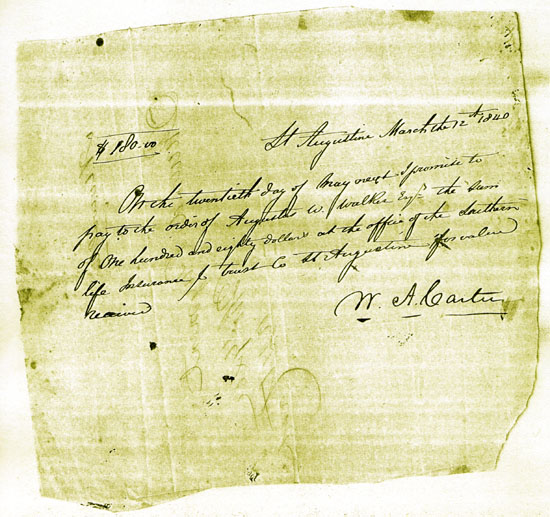
Note from William A. Carter to Augustus W. Walker. Copy courtesy of Florida Historical Society.
The above note was apparently paid by Carter in a timely manner. An undated receipt is attached to the
original. Walker was the Collector of Customs at St. Augustine and an associate with Gen. Henandez. He was
forced into bankruptcy and removed from office. The Southern Life Insurance and Trust Company which had offices in both
East and West Florida became insolvent.
Another creditor, Thomas Butler died. In one lawsuit, it was
contended that Butler's estate was rendered insolvent as a result of the executor's failure to collect debts owed by,
among others, Carter. See, Fairbanks ads. Robb, Alachua County Fla. Superior Court, 1844.
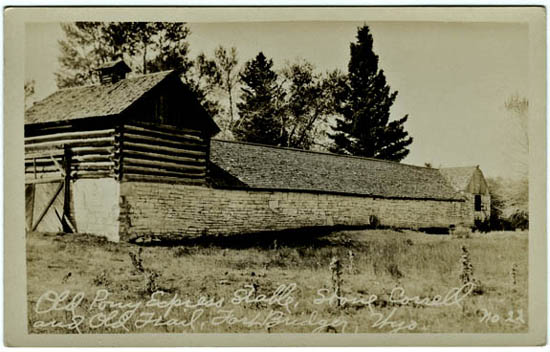
Fort Bridger stables, store and corral, 1926.
The sutler business in Florida, however, was probably less than lucrative. While the position of
a post sutler might be highly profitable at a large post with a civiliam population in the area, the various posts in
Florida were small temporary affairs, with no civilian population. From these small "forts," troops would go out on patrol to keep pressure on the Indians, a tact later used in the
West. The accounts were, therefore, small and, with the soldiers constantly on the move, in some instances
doubtful of collection. In 1840, Carter, as an exammple, wrote to one officer complaining of overdue accounts. Carter enclosed an abstract of accounts due at Palatka from Company "A," 3rd
Artillery, listing some 40 open accounts ranging in size from $1.07 from to $42.07. Apparently, as early as 1840, Carter began considering a
permanent return to Virginia. In May 1840, the Adjutant at Fort Peyton wrote Carter at Key Biscayne reporting that he had heard that Carter
"intended giving up sutting [Sic] for our Regiment and returning permanently to Virginia."
Also adversly impacting on Carter's business in Florida was disease. The largest number of casualties
in the Seminole War was not from Indians, but yellow fever, the "black vomit."
Ninety per cent of those who caught the disease died. Yellow fever was not a respecter
of rank or privilege. The territorial governor Robert R. Reid caught the dreaded disease
and died from its effects. At the time, it was believed that yellow fever was caused by a
"miasma” arising from the fetid decaying vegetation in the swamps. Indeed, the yellow fever
did arise from the swamps, not from a miasma, but from the swarms of mosquitoes which
plagued Florida and St. Augustine in the summer. Indeed, one Florida town, St. Joseph,
in one year, as a result of the disease, declined in population from 6,000 to 400.
While Wyoming honors Chief Washakie and Mrs. Morris in the nation's capital, Florida has a
statute of the inventor of air conditioning. It was intended to assist yellow fever victims in their recovery. With the end of the
war, failing finances, and the need to recover from the yellow fever, Carter returned to Virginia. Gen. Hernandez left the
territory for Cuba.
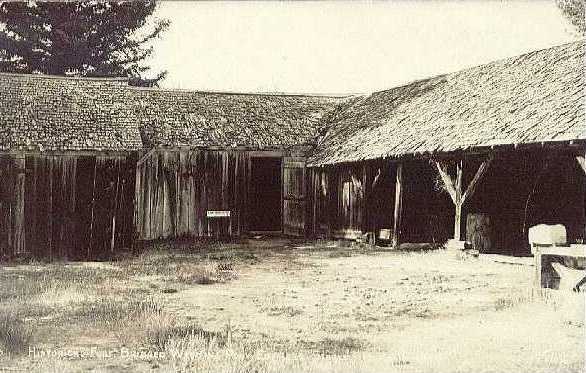
Pony Express Stables, Fort Bridger.
The above series of stables and buildings were constructed by Judge Carter to store his own
vehicles and for the use of the Pony Express. Adjacent to the stables, as shown in the next picture,
was a butcher shop and meat sorage area. Ice was stored in the tall log chinked building and taken into
the meat storage building.
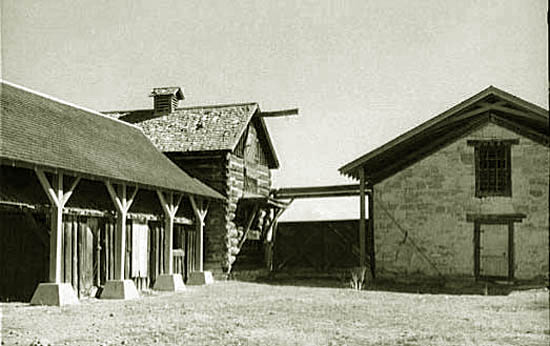
Stables, looking to the log ice house and the stone meat house on
right. Photo by Arthur Rothstein, 1940. Note installation of new protective roof above the original
roofs on the stable and the meat house.
Connected to the meat storage building was a small mess hall for Cater's
employees (depicted on the next page).
Next page: Ft. Bridger continued,
|